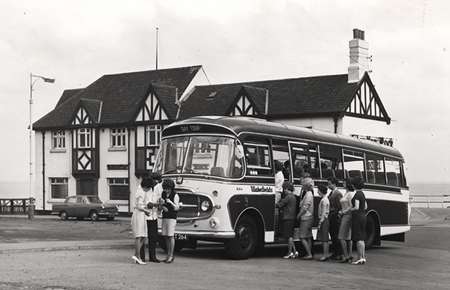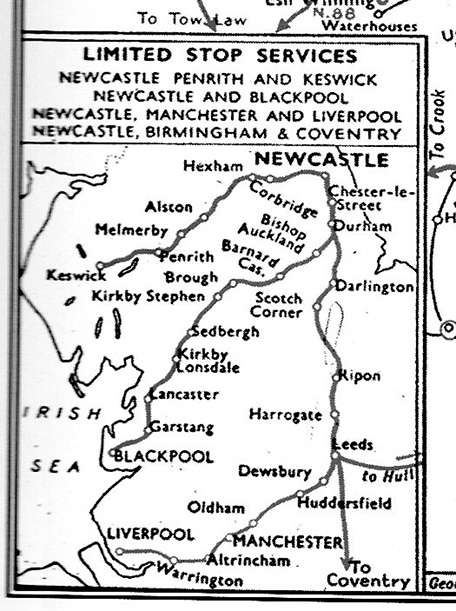
Photographer unknown – if you took this photo please go to the copyright page.
Wakefields Motors Ltd
1963
Bedford SB5
Plaxton C41F
The coach fleets of Northern General Transport and its subsidiaries was pretty much as you would expect from a BET company, usually an AEC, Guy or Leyland chassis, and a mixture of high quality bodies from several different Coachbuilders, so the arrival of these C41F Paxton Embassy II Bedford SB’s in 1963, came as somewhat of a surprise. I’m not suggesting that the SB was a bad vehicle, far from it, the gave many years of loyal service to a multitude of operators, but Bedford’s never played a significant role in the make up of BET group fleets, any that were around had either been bought for a specific purpose or had come in through the back door as the result of a takeover, so your guess is as good as mine as to why two of them came to be at Percy Main? As well as the Wakefields pair, HFT 264/5 – 264/5; I believe Sunderland District also had a some, and I presume all of them would have been either 8’s or 13’s with the Leyland engine, but I’m not aware of any others in the NGT set up. Life expectancy of NGT single deck and D/P vehicles was around 15 years, some of the touring coaches were withdrawn after about 10 years, but many were used for the longer express routes and lasted as long as their service cousins. This wasn’t the case with these Bedford’s. I started at Percy Main in 1967, and if memory serves, they were withdrawn at the end of the 1968 season. As far as ‘coaches’ were concerned, they were the last to carry the Wakefield’s name as all subsequent vehicles were D/P’s, and the name became defunct in 1970. As a footnote, the photo was taken outside The Gibraltar Rock Pub, located at Tynemouth terminus of what was at the time the service 11 to Newcastle, the location is only about 5 miles from Percy Main depot, and to me this photo looks like a publicity shot and the passengers are probably Percy Main office staff.
Photograph and Copy contributed by Ronnie Hoye
15/05/13 – 09:22
Nice view, Ronnie. Thanks for posting. I know of other operators who used office staff in their publicity photos, so your theory in this case could well be correct.
Pete Davies
15/05/13 – 09:23
Yes, Ronnie – a strange choice of coach for a BET company. However, if they did want some lightweights then there was not much choice at the time, other than Ford Traders. I wonder if they were on lease hire, hence their short life with Wakefields?
This scene definitely looks staged. It was a common practice to enrol office staff to act as passengers for publicity shots. I remember one such occasion with Wallace Arnold when we were supposed to be tourists on a Swiss holiday (in the depths of a suburban Leeds country lane). I never saw the resulting pictures. Nobody minded, of course, as it got us out of the office for an hour or two.
Mind you, they couldn’t do this today as HSE would object to those two protuberances which could have someone’s eye out! (Sorry, but this was the age of The Likely Lads and Carry On films!)
Paul Haywood
15/05/13 – 10:57
Bedford? Very strange. Why? Because all the quality mainstream operators at that time tended towards the Ford 510E for their minority lightweight purchases – keeping them no longer than three years, often for only one season. [SUT, Yelloway, Wally Arnold, Hebble, Woollen – all ran Fords rather than SBs. SUT only ran SBs from operators who they had taken over.] OK; NGT ran non mainstream vehicles, including Guy Arab LUFs – but Wakefield ran Reliances, instead.
David Oldfield
17/05/13 – 07:17
“Oh, what happened to you? Whatever happened to me?” Well, Rodney Bewes – his voice at least – was the door announcer for the lifts in the last place I worked!
Pete Davies
18/05/13 – 08:15
Notice anything about “Bob’s” accent, Pete? Yorkshire, if not all that broad – Rodney Bewes is from Bingley. I think its called “auto-suggestion”: you’re told the sitcom is about two “likely-lads” from Tyneside – as and long as one of them has a Geordie accent then you simply don’t hear the Yorkshire tones of his partner. The Northern Fleetline/Atlantean-Alexanders (which would it have been?) in the opening titles have gone, are the Scotswood Road flats still standing? The Dunston Rocket, of Tudor Crisps fame (also now gone), has gone. And I’m not even going to mention Manor steps, aerial ropeways, and multi-storey car-parks from a certain cult gangster film.
From the mid to late 60s there seemed to be more of an interest in lightweight coaches from certain BET and THC operators. Perhaps this reflected a desire to be able to compete more effectively against independents for private hire business as stage-carriage work declined.
Philip Rushworth
18/05/13 – 16:57
David O – Yelloway was not an operator that ran Fords rather than SBs, the opposite was the case. They bought Fords only in 1961, 3 in total, including subsidiary fleets. They bought SBs each year from 1960 to 1965, excluding 1961, a total of 16.
David Williamson
19/05/13 – 07:18
But my point was that they ran Fords, not that they didn’t run Bedfords…..
David Oldfield
21/05/13 – 14:48
There has recently been some discussion on the SCT61 website about a photo of Wakefield’s Motors Beadle-bodied AEC/Beadle rebuilds 191 and 192 (FT 7791/2). The blind on 192 shows ‘PRIVATE’ with ‘RIPON LEYBURN AND RICHMOND’ in smaller capitals underneath. There has been much speculation as to what this destination was intended for and the North-East based followers of that site are mystified. Eric Bawden has suggested that it might have been used for forces’ leave services but I have no recollection of Wakefield’s doing such work and so I’m not convinced.
I wondered if anyone – obviously, I’m particularly thinking of Ronnie Hoye as the Tynemouth/Wakefield’s expert – would know why this particular destination appeared on a Wakefield’s blind.
The photograph was taken in 1960 in Whitby so it doesn’t offer any clues.
Alan Hall
22/05/13 – 07:24
Can’t say for certain, Alan. I know a fair bit about T&W but I’m by no means an expert, but my opinion would be that Wakefields coaches all had the longer Northern express route destinations on their blinds, and vehicles with Percy Main crews could often be found being used as duplicates on some of the routes. If memory serves, the Newcastle Liverpool route ran through Ripon, Harrogate and Leeds, but I cant remember any that went via Richmond or Leyburn.
Ronnie Hoye
23/05/13 – 07:54

I’ve been talking to a friend who was at Percy Main when I was, and he too is at a loss as to why Leyburn and Richmond should be on the destination blind. Wakefields had two batches of AEC Beadles, FT 7275/80 – 175/80 and FT 7791/2 – 191/2; 175/80 were FC35F and classified as coaches, whereas 191/2 were FC39F D/P’s, they also had slightly different fronts, the coaches had more bright trim under the windscreen and no number section on the destination layout. The coach blinds carried all Northern express route destinations, but the D/P’s had a shortened version of the stage carriage blind with the express section added.
Ronnie Hoye
27/05/13 – 06:50
Thanks, Ronnie: I appreciate your trouble but it seems that Richmond and Leyburn are mysteries that have us all stumped.
Sadly, we’ll probably never know now.
I’ve dug out an old timetable from that era (1959, as it happens) which shows the hospital services which were licensed to Northern and Wakefield’s (no other group members), but nothing from as far away as Richmond or Leyburn features. As a matter of interest, the ones from the North Tyneside area (presumably the ones which were operated by Wakefield’s) were North Shields to Prudhoe Hall Colony – what a dreadful name, Wallsend to St George’s Hospital at Morpeth and North Shields to Earl’s House Hospital near Durham.
I think that’s my earliest Northern Group timetable but I have others from the ’60s which are stored at my mother’s house. I’ll look them out next time I’m there on the off chance that they may lead us to the solution.
Alan Hall
04/06/13 – 06:49
Ronnie, I’ve now checked the 1960, 1961 and 1962 timetables and there isn’t anything in any of those to indicate why Richmond and Leyburn might have been on Wakefield’s blinds.
I wonder if it was simply wishful thinking. You’ll remember that Newcastle’s trolleybus blinds included several places South of the Tyne, such as Dunston, Gateshead and Low Fell, in the hope/expectation that the wires would eventually cross the river as the tram wires had. I suspect that this may have been a similar example of ‘ready in case ever needed’.
Alan Hall
05/06/13 – 10:58
Alan, I have no evidence to back up this theory, but the only thing I can think of is perhaps Northern applied for an additional alternative route for the Leeds service, but this was United territory, and no doubt they would have objected strongly unless it was going to be a shared service.
Ronnie Hoye
30/12/13 – 07:13
Just discovered your site today while searching for pics of the type of coach I drove during my service at R.A.F College Cranwell. Exactly what I was looking for, in fact as my coach was 27AC58. My home town was Scarborough which was very lucky for me as I was given the job of taking the college band to Scarborough for their annual fortnight visit.
Robert Robinson
10/04/15 – 07:27
I have a couple of photos of Wakefields vehicles showing Scarborough as a destination. That would not be a normal destination for a Northern Group Express coach unless it was the practice to hire them to United on Summer Saturdays for their Newcastle-Scarborough service. However, Scarborough was a destination for day tours. On the assumption that Ripon, Leyburn and Richmond was also a day tour, I have visited North Shields library to look for Wakefields Adverts for their tours in the local newspaper, and can confirm that this was indeed a Wakefields day tour.
John Gibson
 Vehicle reminder shot for this posting
Vehicle reminder shot for this posting
08/03/16 – 05:26
I knew I wasn’t imagining this, SDO had two identical vehicles, 3730 & 3731 UP – 330/1, and Northern had eight Bedford’s with C41F Harrington bodies, PCN 1/8 – 2601/8. I dont know about the rest, but the two for Wakefields were sold on after three years, and went to Hylton Castle Coaches of Sunderland
Ronnie Hoye
Leave a Reply